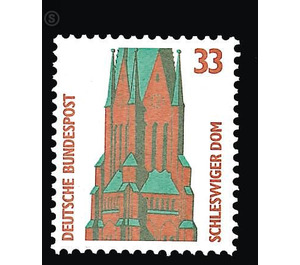Postage stamp: sights - Germany / Federal Republic of Germany 1989 - 33 Pfennig
Theme: Architecture
| Country | Germany / Federal Republic of Germany |
| Issue Date | 1989 |
| Face Value | 33.00 |
| Color | brown white |
| Perforation | K 14 |
| Printing Type | indirect 2-color letterpress |
| Stamp Type | Postage stamp |
| Item Type | Stamp |
| Chronological Issue Number | 1272 |
| Chronological Chapter | GER-BRD |
| SID | 286339 |
| In 40 Wishlists | |
With »Landmarks«, the Deutsche Bundespost replaces the series »Castles and Palaces«, begun in 1976/77. The new permanent series with its extraordinary representations of significant cultural and technical achievements out, but should also be an incentive to look at the objects once in the original. Of the new role brands - they appear at the same time and continue the series - the 20 Pf and the 140 Pf value will be identical in the issues »Deutsche Bundespost Berlin«, the 33 Pf and the 38 Pf value only published in the issue »Deutsche Bundespost«. The St. Peter's Cathedral in Schleswig is the old episcopal church of 948 founded by Emperor Otto I diocese, which at that time was the intersection of continental European, Slavic and Scandinavian empires and interests. After 300 years of Christian tradition and 200 years of diocesan history, St. Peter's Cathedral was first mentioned in writing in 1134, although the start of construction is much earlier. The three-aisled and 76 m long main church of the former Duchy of Schleswig is essentially an elongated, Gothic brick building with a Romanesque transept. Over the centuries, many have rebuilt, added and taken away, without, however, reshaping the whole thing. Towards the end of the thirteenth century, on the north side of the nave, was the cloister, a Gothic three-winged brick complex, praised as a masterpiece of medieval architecture and "Schwahl" (from the Danish sval = cool, svale = cool - "breezy called "cool gear"). On the vaulted ceilings frescoes and drawings from around 1300 can be seen. The St. Peter's Cathedral in Schleswig has numerous and precious works of art from all periods of its more than 850 years of history. No less colorful than the history of the building is that of its interior decoration. In a spatial structure are epitaphs from the 16th to 18th centuries on pillars and walls, Freiplastische wooden groups in the north and south nave, the late Gothic louvre and the choir stalls of 1512 and the unique glass window ensemble from the 19th century. The richness of these diverse works makes a great charm of the 1527 Protestant cathedral. The desire of the Dukes to increase the reputation of their cathedral by magnificent monuments, the church owes its most precious treasure, the 1521 by Hans Brüggemann originally for the monastery church in Bordesholm created high altar. The "Bordesholmer Altar" arrived in 1666 from Bordesholm in the now used as Hofkirche Schleswig Cathedral. Brüggemann worked in free reference to his contemporaries Albrecht Dürer and Tilman Riemenschneider. The groups are carved as a whole from oak blocks and without painting, the carving shows in almost 400 figures the whole costume wealth of his time. (Text: Head of the State Chancellery of Schleswig Holstein, Kiel)


